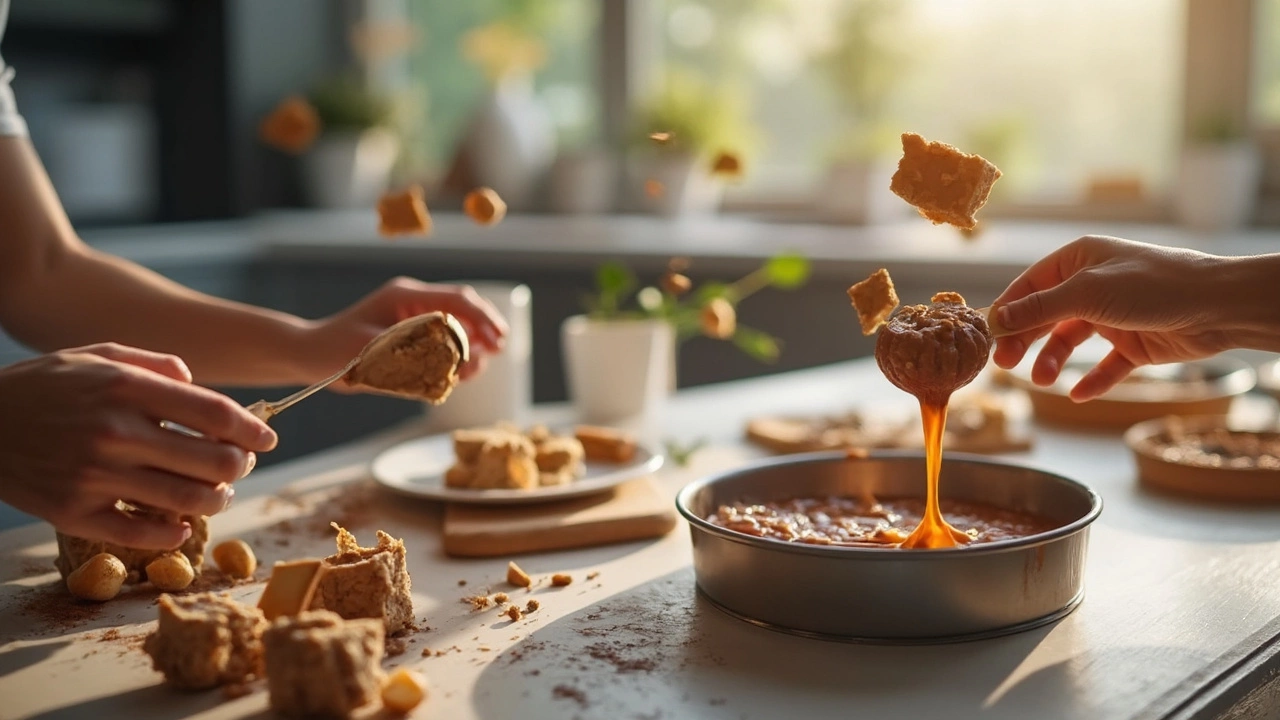Ask someone in the US about fudge, and you’ll hear one answer: it’s a rich, creamy confection, usually chocolate, but sometimes peanut butter, maple, or even birthday cake flavor. Americans call it fudge—plain and simple. There’s no fancy translation or alternative name. It’s a sweet treat you’ll see at county fairs, tourist towns, and even in homemade holiday tins.
If you walk into almost any old-fashioned candy shop in the States, fudge will be proudly on display, sliced into squares and wrapped in wax paper. People expect it to be dense but smooth, sweet but not overly so, with a slight grain that tells you it was made the classic way—boiled, then beaten as it cools until it thickens into perfection. The word 'fudge' is pretty much locked in when it comes to this exact treat, and Americans wouldn’t call it anything else.
- The American Definition of Fudge
- How Fudge Is Different From Other Treats
- Popular Fudge Flavors in the US
- Regional Fudge Traditions and Stories
- Tips for Making Classic American Fudge
The American Definition of Fudge
In the US, when people say fudge, they mean a dense, smooth, really sweet candy. The classic version is chocolate, but the base definition stays the same: it’s made by heating sugar, butter, and milk, then beating the mixture as it cools. That’s what gives American fudge its signature creamy feel. Anything that strays from this—like chewy caramels or crumbly British tablet—wouldn’t be called fudge here. In American kitchens, fudge is all about that soft, melt-in-your-mouth bite, sometimes with nuts, marshmallows, or candy pieces mixed in.
What makes this treat different? It’s the process. By cooking it to just the right temperature (usually 234°F, also called the 'soft-ball' stage in candy making) and mixing it just enough, you get a texture that’s in between cake icing and caramel. Too little mixing and it stays syrupy. Too much, and it dries out or gets gritty.
Fudge in America doesn’t have to be chocolate, but that’s the most popular version by far. Here’s a look at the usual suspects you’ll see in every sweet shop:
- Chocolate fudge
- Peanut butter fudge
- Maple fudge
- White chocolate fudge
- Mint fudge
If you check out any American recipe book or box of fudge mix, you’ll see those flavors everywhere. The technique matters more than the flavor. As long as it follows the sugar-milk-butter base and the famous beating process, Americans will call it fudge. Simple as that.
How Fudge Is Different From Other Treats
Walk down the candy aisle, and you'll see all sorts of sweet stuff—but fudge stands out for more than just its flavor. In the US, fudge has a unique texture that’s halfway between a chocolate bar and the gooey middle of a brownie. It isn’t chewy and it isn’t crisp. Instead, it’s creamy, dense, and for classic fudge fans, just a little bit grainy. That graininess means it’s been made right—boiled, cooled, and beaten until tiny sugar crystals form.
Don’t confuse American fudge with chocolate truffles, caramel, or toffee. Chocolate truffles melt instantly in your mouth and are super silky, thanks to heavy cream. Caramel stretches when you pull it apart, and it’s made by cooking sugar and butter until deep golden. Toffee snaps with a hard bite. Fudge, though, holds its shape, slices easily, and gives you that dense square of satisfaction.
Here’s a comparison that makes it clearer:
| Treat | Main Ingredients | Texture | Common Flavors |
|---|---|---|---|
| Fudge | Sugar, milk, butter, often chocolate | Creamy, slightly grainy | Chocolate, peanut butter, vanilla |
| Caramel | Sugar, butter, cream | Chewy, stretchy | Caramel, sea salt |
| Chocolate Truffles | Chocolate, heavy cream | Silky, melts instantly | Chocolate, ganache |
| Toffee | Sugar, butter | Hard, crunchy | Butter, almond |
You might wonder why Americans are so picky about what counts as fudge. For a lot of people, it’s personal. "American fudge is about comfort, nostalgia, and the texture that hits right in the middle of creamy and firm," says
"Fudge is special because of its texture—something you don’t get with any other candy," — Kate Hopkins, author of 'Sweet Tooth: The Bittersweet History of Candy'.
So, if you see a square treat that looks dense and smells like chocolate or peanut butter, chances are you’re looking at fudge—the American kind that’s its own category, not just another candy.

Popular Fudge Flavors in the US
When people picture fudge in America, most imagine classic chocolate first. It’s hands-down the most popular pick, and it’s been made the same basic way since late 1800s college dorm rooms turned out the first batches. But honestly, chocolate is just the start. The US loves variety, so shops and home cooks whip up all kinds of flavors that keep things interesting.
Here are some favorites you’ll find in every corner of the country:
- Chocolate Fudge: The original. Usually made with cocoa powder or real chocolate, sugar, butter, and milk. Some recipes toss in walnuts for a crunch.
- Peanut Butter Fudge: Major fan favorite, especially in the Midwest and South. It’s sweet, salty, melts in your mouth, and you’ll spot it at bake sales everywhere.
- Maple Fudge: Really shines in New England, especially Vermont. It’s usually made with real maple syrup (not just flavoring!) and has that buttery, caramel-like flavor.
- Rocky Road Fudge: Imagine classic chocolate fudge loaded with mini marshmallows and chunks of nuts. It’s a crowd-pleaser for anyone who likes a little texture.
- Cookies and Cream: Oreos crushed into sweet, creamy fudge. Kids (and honestly, most adults) can’t resist it.
- Penuche: More common in the Northeast, penuche is all about brown sugar and butter. No chocolate, just caramel vibes with a lighter color.
There are also bolder flavors popping up lately—birthday cake, pumpkin spice, even caramel sea salt—all showing up at craft fairs and boutique candy shops. Americans really run with creative ingredients, adding swirls, layers, and toppings whenever they want to make a batch feel special.
Just how popular are these fudge recipes? Here’s a quick look at best-sellers at a few US fudge shops last year:
| Flavor | Percent of Total Sales |
|---|---|
| Chocolate | 42% |
| Peanut Butter | 18% |
| Maple | 12% |
| Rocky Road | 10% |
| Cookies and Cream | 8% |
| Other/Seasonal | 10% |
So, if you’re looking to try something new or want to impress with a homemade treat, you can’t go wrong starting with one of these winning flavors. People love them, and there’s a good chance your favorite is in the mix too.
Regional Fudge Traditions and Stories
The story of fudge in America is full of quirky towns and local legends. Nowhere gets more attention than Mackinac Island in Michigan. Tourists call it the "Fudge Capital of the World"—every summer, people walk off the ferries and head straight for the aroma coming out the doorways of almost two dozen fudge shops. A local nickname for tourists is actually “fudgies.” These shops use traditional recipes that date back over a hundred years, and they put on a show, mixing and shaping creamy fudge on marble slabs right in front of you.
Up in the Northeast, especially in New England, fudge became popular at women’s colleges in the late 1800s. The first written American recipe for fudge came from Vassar College. Students would sneak into the kitchen and whip up small batches as a rebellious treat. That homemade vibe is still a big deal in the region—especially around the holidays, when families use hand-me-down recipes that have traveled through generations.
Down South, you’ll find fudge popping up at church bake sales and family reunions, but sometimes with a twist—think pecans or bourbon for a local flavor. Out West, fudge hits the shelves of national park gift shops and is a classic in smaller mountain towns, often made with ingredients from nearby farms like local honey or berries.
Check out some specific examples of how fudge is celebrated in different US regions:
- Mackinac Island, MI: Hosts an annual Fudge Festival with events like fudge-making contests and tastings.
- Cape Cod, MA: Famous for its saltwater fudge versions, blending local sea salt for a unique bite.
- Tennessee and Kentucky: Peanut butter fudge is a staple at festivities and as a homemade holiday gift.
Fun fact—each shop or family adds their own spin, whether it’s ingredients, how they cook it, or how they serve it. That’s what keeps fudge a living tradition, not just a sweet from the past.

Tips for Making Classic American Fudge
Making fudge at home seems simple, but anyone who’s tried knows there’s a little science (and a bit of patience) behind getting it just right. Here are practical tips to help you make old-fashioned American fudge that’s creamy and not crumbly or gritty.
1. Watch Your Temperature
A candy thermometer matters. For classic fudge recipes, bring your mixture (usually sugar, milk, butter, and chocolate or flavoring) to exactly 234–238°F (known as the “soft-ball stage”). If you skip this, your fudge can turn out too stiff or too runny. Most people who get grainy fudge didn’t hit the right temp!
2. Beat at the Right Moment
After reaching the right temperature, let your fudge cool undisturbed to about 110°F. Don’t poke it or stir. Once it’s cool enough, beat it by hand or mixer until it loses its shine and gets thicker. This step breaks up sugar crystals, giving that perfect texture.
3. Use Quality Ingredients
Your fudge will only be as good as what you put in. Real butter (not margarine), good chocolate, and whole milk make a serious difference in taste and creaminess.
4. Don’t Rush
Shortcuts ruin fudge. Stirring too soon or not waiting for the thermometer leads to problems. Give fudge the time it asks for, or you’ll get a mess instead of those dreamy squares.
5. Storage Is Key
- Wrap your fudge in wax paper or plastic wrap so it doesn't dry out.
- Store at room temperature in an airtight container for up to 2 weeks.
- Want to save it longer? Fudge freezes well—just double-wrap and thaw at room temp.
6. Quick Fixes
- Grainy fudge? Re-melt it gently, add a tablespoon of water or cream, and beat again.
- Too soft? It didn’t get hot enough—try cooking a batch longer next time.
For perspective, a classic chocolate fudge recipe uses about 3 cups sugar to ¾ cup milk and ½ cup butter for a standard 9-inch pan. It’s not low-calorie by any means. Here’s what the ingredient balance usually looks like:
| Ingredient | Amount (Standard Batch) |
|---|---|
| Sugar | 3 cups |
| Butter | ½ cup |
| Milk | ¾ cup |
| Chocolate Chips | 1½ cups |
| Salt | ¼ tsp |
| Vanilla Extract | 1 tsp |
If you love American fudge, remember: keep your thermometer handy, don’t rush, use good butter, and wrap it well once cooled. That’s the best way to get perfect fudge every time, whether you’re making it for the holidays or just as a treat.